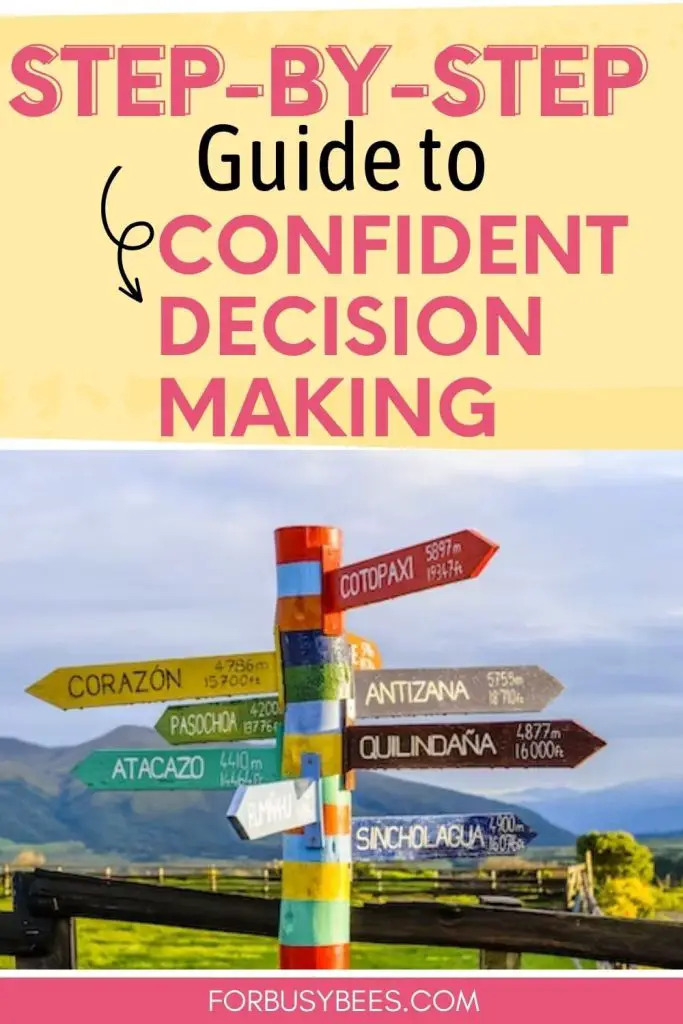Easy to Follow Decision Making Process

Each day of life we make small and big decisions. Making decisions can feel daunting if you do not have a decision making process. Most of the time we make decisions by listening to what others say or choosing something that is easy. However, every decision you make can impact your life and need to be made carefully considering your needs and aspiration in life. Although there are many ways to make a decision and there is no one fit-all, in this post I have tried to simplify the decision-making process and make it practical to follow.
Let’s have a look at how to make decisions in life.
Why do you need your decision making process?
- Whether you realize it or not, decision-making plays a crucial role in every aspect of your life, both personally and professionally.
- By honing your decision-making process, you can avoid costly mistakes, maximize opportunities, and ultimately achieve your goals more efficiently.
- A structured decision-making process helps you gather relevant information, consider potential alternatives, evaluate risks, and weigh the pros and cons before taking action.
- Without a well-defined decision-making process, you may find yourself overwhelmed, indecisive, or prone to making impulsive choices that you later regret. Therefore, investing time and effort into developing a thoughtful decision-making process is essential.
How to Make a Decision
Here is a step-by-step process to help you make decisions in life. You may not need to follow all the 10 steps of the decision-making process for all the decisions in life. Some may be quick to make following just the initial process however some may need more detailed consideration. So based on the criticality of the decision make the choice.

1: Identify the issue and results you need
- The first step to making a decision is to get clarity on issue at the hand. As trivial as it may sound being clear on the issue, the decision you need to make, and the vision you have in your life will make the process of decision-making easier and more effective for you.
- By clearly defining the issue at hand, you have an understanding of what needs to be addressed or resolved and can make an informed decision. This also avoids hasty decisions.
- Once you have clarity on the issue think about the results you desire in your life. You need to consider your ambition, values, and vision for life your decision must align with all of these.
- Identifying the issue and result beforehand enables us to approach decision-making with a clearer mindset and increases the likelihood of positive outcomes.
2: Determine the criteria and factors that contribute to decision
- When you are making a decision identify the criteria that you must consider while making the decision and various factors that are related to the decision at hand.
- Based on the decision you need to make these criteria and factors are totally variable and may be unique to your life. Certain decisions may also affect people around you and the impact it can bring to other’s life must also be considered.
- The criteria can be both objective and subjective such as cost, time constraints, potential your vision for life, feasibility, quality, and desired outcomes. The factors contributing to decision-making can vary greatly depending on the context, such as personal preferences, available resources, past experiences, market trends, and the impact on other life.
- The criteria and factors will be very different when you are making decisions for personal life, at work, and in business. With careful consideration, you are more likely to make the right decision.
3: Consider your options
- Depending on the situation you may be provided with two options to choose from or you are not provided with any options to choose it may be a situation like take it or leave it. But you must look out for options.
- It is crucial to thoroughly evaluate and explore different paths before settling for one. Rushing into choices without exploring options may lead to regret or missed opportunities.
- You may end up in a situation where you feel there is no alternative to choose but taking a step back and thinking of possibilities with a mindset of abundance rather than getting intimidated by the situation may open so options for you to consider.
- Often speaking to people who wish well for you or are experienced may lead you to some options that you could not see.
4: Weight Pros and Cons
- One of the best ways to make decisions is to identify the pros and cons.
- I like to list both next to each other in a notebook and think over it before making a decision. The pros represent the potential benefits and advantages that come with a specific choice, while the cons are the disadvantages and negative consequences of the option.
- This way of making a decision is more suitable when the criteria and factors are more qualitative and yes or nature.
- By following the pros and cons method for making a decision most of your thoughts regarding the decision will be streamlined, and any biases or thoughts clouding your judgment will be reduced.
5: Evaluate your options
- Once you are clear of the criteria that govern the decisions and the options available to you. It is best to rationally evaluate them after getting all the information pertaining to the decision you need to make.
- You should consider each option against all the criteria listed to determine the best option.
- To make the process easier and more effective you can score all the available options for each criterion on a scale of 0 to 5, where 0 is the least and 5 is the maximum score for the criteria under consideration and the option that has the best score should be your best option based on all the criteria you have considered and against all the available options.
- This form of decision-making is best to avoid hesitation, biases, and cognitive limitations.
- This way of making decisions is more appropriate if you are making decisions at work or business as the results can be presented when you are questioned about the reason you made the decision.
- This analytical approach ensures a thoughtful and well-rounded decision-making process.

6: Consider risks and uncertainties
- Once you have weighed all your options and narrowed down to a decision you should consider any risk, if associated with the decisions.
- It may not always be necessary that there are high risks associated with the decision but sometimes they may be critical and must be considered before making a decision.
- I like to imagine the worst that can happen, it prepares me mentally and emotionally for unforeseen challenges and make strategic decisions.
- You should also consider uncertainties that may appear in the future such as external factors, personal limitations, and unforeseen conditions. These may not necessarily happen but you have to consider the possibilities before making a final decision.
- At times based on the risks and uncertainties, the second-best option may be a wiser decision if the best option comes with high risk.
7: Review the consequences
- After all these considerations you must have arrived at your decision and if not you will have definitely narrowed it down to 2 or 3 possible decisions.
- Before making the final decision take into consideration the consequences of the decision that you make.
- These consequences may be positive as well as negative. There is no decision that comes without consequence you just need to make the final call thinking about the worthiness of possible consequences that can be expected.
- The consequences may not just be limited to you and your life but also to people around you. Have foresight for the long-term impact too. But at the same time note that for certain situations you just need to consider immediate impact as they may not be for long-term goals.
8: Trust your gut
- In case of indecision or having options that seem equally good, take a moment to connect with yourself and listen to your gut feeling.
- Our gut feelings often hold valuable insights that should not be disregarded.
- Gut feelings or intuition are not just feelings but our subconscious mind that has processed a lot of information to make you feel more inclined towards one option than another.
- Our brain has a remarkable ability to hone in on the subconscious signals, nudges, and subtle reactions that we may not consciously be aware of and give us an intuition to make a decision.
- So, anytime you have an intuition about a decision try to consider it and think of reasons, benefits, and consequences it can bring to your life to be more rational about taking the decision. By embracing and acknowledging our gut instincts, you can strengthen your decision-making abilities.
9: Reach for experts or resources
- In case of dilemma reach experts on the topic pertaining to the decision and seek their suggestions.
- If you cannot find an expert, you can contact someone with experience. You can also reach out to someone you consider trustworthy and have the best interest for you to discuss and have a fresh perspective.
- For opinions on the subject matter, you can also do research online, and refer to some informative articles, market trends, and regulations to make an informed decision.
10: Mitigate or have a Plan B
- Once you have made your decision and if it has any possible risk associated with it look out for ways to mitigate the risk.
- Risk mitigation is preparation to lessen the effects of risk.
- The risks that bring bigger threats and are more probable must be addressed by mitigation.
- Also, at times it happens that there is no possible risk with the decision but implementation of the decision can be difficult making it more likely to give you the benefits you were expecting. But they are still worthy of making an effort in such cases it is wise to have a backup plan, the plan B to keep you prepared in case of a downfall.
- Also for risks where mitigation is not possible, you can have a plan B.

Conclusion
Making the right decision is overwhelming but having a strategic approach towards making a decision can help you make decisions more rationally and keep you informed of the challenges and risks that can bring. Not all decisions in life need to follow all the steps mentioned in this post but critical decisions in life and at work or business will be more reasoning and result-based when you follow the steps mentioned in this post.
Related posts you may like:
How to Reset Your Life to Improve Yourself







